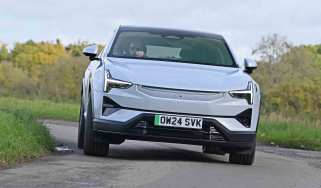Citroen Berlingo review - Engines, performance and drive
Typical family SUVs handle better and offer more refinement, but the Berlingo is comfortable and very easy to drive

The Berlingo’s underpinnings are a mish-mash of technologies. The rear half is largely unchanged from the previous model, allowing for a similarly huge load area, while the front is based on the EMP2 platform used by cars ranging from hatchbacks to family SUVs. Doing so allowed Citroen to install the latest suite of safety tech and chassis refinements.
The result is that, for the most part, the Berlingo drives more like a car than a van. The steering is light, the turning circle is tight and, while the high centre of gravity makes itself felt during hard cornering, body roll is controlled well enough. There's decent grip and the brakes feel strong and reassuring.
The ride is smooth enough, though the harshest bumps vibrate around the cabin. There’s quite a lot of wind noise at motorway speeds, particularly around the bulky door mirrors, but that’s not particularly surprising considering this is a large box on wheels. At least the large amounts of glass, big side mirrors and slightly elevated driving position mean you get a decent view out.
Driving the electric e-Berlingo is largely the same, but with the added benefits of near-silent running, no gearbox to deal with and a generous amount of torque available as soon as you tap the accelerator. The e-Berlingo is great when you’re pottering around town, especially when you engage the ‘B’ mode that increases the regenerative braking, though it’s not capable of one-pedal driving like some other family-friendly EVs.
0-62mph acceleration and top speed
Under the bonnet, there’s a choice of a 1.2-litre petrol with 108bhp, a 1.5-litre diesel in one of two power outputs – 99bhp and 128bhp – and a single electric motor with 134bhp on tap.
Used - available now

2020 Citroen
Berlingo
31,237 milesManualDiesel1.5L
Cash £16,599
2020 Citroen
Berlingo
24,500 milesManualDiesel1.5L
Cash £12,450
2020 Citroen
Berlingo
67,749 milesAutomaticDiesel1.5L
Cash £13,609
2021 Citroen
Berlingo
26,927 milesAutomaticPetrol1.2L
Cash £21,024The most powerful diesel offers up a useful 300Nm of torque – handy when carrying a full complement of passengers and their luggage. The top-end diesel accelerates from 0-62mph in 11 seconds and on to a top speed of 114mph. The entry-level oil-burner is a little bit slower on paper, as Citroen says this version takes 14.1 seconds to reach 62mph, and it has a slightly lower 106mph top speed, though that shouldn’t concern UK drivers.
The 108bhp petrol model’s 11.5-second 0-62mph time translates into decent real world performance, while the linear power delivery makes the Berlingo easy to control at low speeds. The petrol Berlingo also has a top speed of 107mph.
Whichever fuel you go for, the Berlingo remains fairly smooth and refined, with the two diesels the better pick for regular longer trips or towing duties.
Available gearboxes include a six-speed manual and an eight-speed automatic, though the one you’ll be able to have depends on which engine you go for. The manual is the only gearbox offered on the 108bhp petrol and 99bhp diesel; in contrast, the 128bhp only comes with the auto.
The e-Berlingo’s electric motor sends all its 134bhp and 260Nm of torque to the front wheels, and will sprint to 62mph in a leisurely 11.5 seconds, with a modest top speed of 84mph. The EV’s three driving modes – Eco, Normal and Power – affect the amount of power on tap, with the most powerful reserved for when the car is chockablock with people and their stuff.
Day to day around town, we’d recommend driving the Citroen in Normal mode, and switching to Eco for when you have to get the most range out of the battery as this setting not only limits power, but the climate control as well, which isn’t great in the blistering heat or freezing winters.










